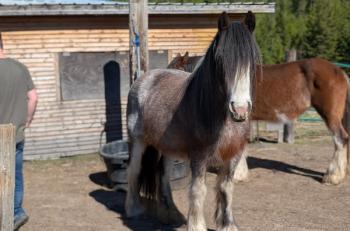
Endoscopic examination stallions (Proceedings)
Endoscopic examination in the stallions is indicated in cases where blood (hemospermia), pus or (pyspermia) in the semen or urine, treatment for seminal vesiculitis, pain on ejaculation, or there is an inability to emit semen.
Indications for Endoscopic examination of the stallion
Endoscopic examination in the stallions is indicated in cases where blood (hemospermia), pus or (pyspermia) in the semen or urine, treatment for seminal vesiculitis, pain on ejaculation, or there is an inability to emit semen. Ascending infections of the genitourinary tract and reproductive organs, including the urethra, accessory sex glands, bladder, testis and epididymides are relatively uncommon in stallions. Endoscopy is used to evaluate the urethra, openings of the accessory sex glands, and bladder. It is a key part of the examination in cases where there is hematuria/hemospermia or pyuria/pyspermia is present. The seminal vesicles are poorly penetrated by systemic antibiotics, so endoscopy is used to catheterize the common ejaculatory duct, to enter the affected vesicular gland. Traumatic injury to the penis and subsequent hemospermia is a common complaint due to indiopathic factors or breeding injuries. Unusual remanants or other conditions / abnormalities may also be assessed using this approach.
Normal anatomic features
Using endoscopy the portions of the stallion's reproductive tract that may be visualized include: sheath, urethral opening, penile urethra, pelvic urethra, colliculus seminalis, and bladder. The two common ejaculatory ducts of the ampulla and seminal vesicles open on the colliculus seminalis which is positioned dorsally in the urethra. The accessory sex gland openings that are visible include: prominent bulbourethral gland openings in rows, small prostatic ducts, in addition laterally positioned urethral glands are also visible along the urethra. The opening to the bladder is behind the colliculus seminalis and is visible at the termination of the urethra [1].
Common conditions of the prepuce, penis and urethra that may be evaluated endoscopically will be reviewed.
The penis of the stallion has a telescoping arrangement so that in the non-aroused state it is retracted and located in the sheath or prepuce. The prepuce orifice also called the preputial ring of the stallion is located on the ventral abdomen. The endoscope may be directed up a short distance into the preputial opening so that part of the exterior and interior portion of the external preputial cavity (sheath) of stallions and geldings may be visualized. The glans penis should be immediately visible in the interior. In order to examine the penis and internal and external preputial lamina, the stallion may be sexually aroused by teasing mares in estrus so he gains an erection and/or he is sedated to allow the penis to relax and extend from the sheath. Geldings are usually sedated. Alpha agonists such as xylazine, and detomidine are useful for the purpose of sedation, and may be combined judiciously with acepromazine. Caution is advised when using acepromazine, because it has been reported to be associated with penile priapism (paralysis). Following arousal from sedation with acepromazine a reasonable precaution is to monitor the stallion to insure he retracts his penis, or encourage him to retract his penis by walking, application of cold water etc.
A few stallion/gelding may present with a history of never dropping the penis for urination, excess discharge or smegma production, foul smell, trauma, unusual growths, palpable mass, phimosis etc. Young colts initially have the prepuce attached to the penis and over time it will separate. Insect bites in young colts or in horses with docked tails may result in swelling in this tissue and a subsequent failure to fully retract the prepuce. The attachments of the prepuce to the penis may take a while to remodel in young colts and this condition resolves on its own without treatment.
Scaring, or space occupying masses on the penis or the prepuce may prevent penile protrusion. In these cases endoscopy of the prepuce may be used. The prepuce may be effected by: tumours such as squamous cell carcinoma, melanoma, lymphosarcoma, and sarcoids. Balanitis (infection or inflammation of the prepuce) may accompany coital exanthema, habronemiasis, insect hypersensitivity, trauma or other bacterial infections.
Conditions of the prepuce and penis. Squamous cell carcinoma (SCC) is the most common tumour of the external genitalia in horses. Breeds of horses with little skin pigment such as appaloosas, and paint horses, or light coloured horses such as cremellos, or buckskins are more commonly affected. Owners often report an objectionable smell and/or discharge coming from the prepuce. SCC lesions are usually located on the internal preputial lamina, penis and glans penis. The lesions may be raised spots or deep ulceracted sores. Lack of skin pigment and exposure to UV solar radiation s believed to be the main inciting cause. Surgical options include resection of the affected skin, prepuce or penile amputation, cryotherapy, chemotherapy (topical 5-Fluorouracil), and radiation therapy have been used to treat lesions.
Penile hypoplasia
A history of never having seen the penis dropped has been reported in a case of Persistent Mullerian Duct Syndrome due to penile hypoplasia. The horse had no history of castration but had the phenotypic appearance of a gelding, and a rudimentary uterus. The shaft of the penis was very short which mechanically would not allow the penis to protrude from the sheath. The glans pensis should be visualized with the endoscope.
Figure 1 Shows squamous cell carcinoma lesions involving the glans penis in a paint stallion
Foreign bodies include penetrating pieces of wood, stallion rings, misplaced rubber bands from malfunctioning artificial vaginas, and organic matter.
Urethra in the stallion is long. It has dual functions of carrying urine and sperm. The proximal protion is at the neck of the bladder, while the distal portion ends on ventral portion of the glans penis. Indications for endoscopic evaluation of the urethra include: hematuria, hemospermia, abnormal urination, pyspermia, fertility problems, and palpable accessory gland abnormalities.
Urethral endoscopy
The stallion is restrained in a stocks, his tail wrapped and he is sedated to allow for examination, cleansing of his penis, and passage of the endoscope. The endoscopic equipment should have been sterilized, and any residual disinfectant is rinsed off. The sides of the endoscope are lubricated. The reservoir of the endoscope should be filled with sterile water or saline. The opening to the urethra is wiped and the examiner passes the equipment through the urethra should wear sterile gloves. A 1 meter endoscope is usually needed as the penis of a light horse stallion is approximately 50 cm long. The penis is approximately 6cm in diameter. There is a large degree of variation in penile length and diameter by breed and individual. The urethra may be examined in its full length using a flexible gastroscope or videoendoscope that is at least 1 m in length.The endoscope is advanced very slowly through the urethra with intermittent or low airflow. The urethra should appear closed at the end of the field of view (fig 2). This optimises the chance of observing urethral lesions. Once a lesion(s) have been located more insufflation may be used to dilate the urethra to determine the extent of the injury. Over-extension of the urethra creates artefacts and is the most common error. Over distension with air results in dilation and blanching of the urethra, and blood may be observed to rush back and forth in response to changing insufflation pressures. This odd appearance is sometimes confused with urethritis,and the streak like appearance of the blood misidentified as hemorrhage. The urethra is followed until it turns from the penile to pelvic portions. The extent of penile relaxation and the length of the penis will determine the distance to the pelvic urethra where the accessory sex gland openings and the bladder opening are located (fig 3).
Figure 2: View of the urethra with the recommended degree of insufflation. The mucosa should appear pink and the lumen should not be dilated
The region of the urethra near the junction between the penile and pelvic injury is a hot spot for lesions, and should be carefully examined. Following examination of the penile urethra the insufflation pressure may be increased to allow viewing of the structures in the pelvic urethra. In the pelvic urethra the anatomic structures include the prominent openings for the bulbourethral glands, which are found on the midline, usually in 2 longitudinal rows followed by the smaller and laterally located urethral glands. The small pin point openings of the prostate are visible near the colliculus seminalis. The common ejaculatory ducts of the ampullae and seminal vesicles open on the colliculus seminalis. The caudal most structure is the opening to the bladder which has a different colour. The colliculus seminalis is located dorsally, which is important in deciding which gland opening to cannulate. Rectal massage of the accessory sex glands may result in discharge coming from the vesicular glands in cases of seminal vesiculitis. This material may be cultured.
Figure 3: View of a dilated pelvic urethra showing the colliculus seminalis (grey arrow) and bulbourethral gland openings (white arrow).
Pathologic conditions: Urethritis
Urethritis is inflammation of the urethra usually caused by bacterial infections of the caudal urethra. Ascending infections may also spread the infection. Bacteria such as Streptococcus equi subspecies zooepidemicus, E.coli, and Actinobacillus have been reported in pure or mixed cultures to cause urethritis. The region of the urethra near the penile opening may be impinged upon by concretions of smegma called beans in the urethral fossa. The small concretions may mechanically pinch the urethral opening and cause irritation.
Seminal vesiculitis
Seminal vesiculitis is an uncommon condition of stallions that is believed to be cause primarily by an ascending bacterial infection. One or both seminal vesicles may be affected. In cases of seminal vesiculitis, the seminal vesicles may or may not be enlarged on rectal examination, or have an abnormal echotexture. Semen from affected stallions contains neutrophils and bacteria. A proportion of the mares bred to a stallion with seminal vesiculitis may develop a sexually transmitted bacterial endometritis caused by the same organism. Infections with Klebsiella, and Pseudomonas, and mixed growth are most common. Pyspermia, neutrophils in the semen, is presentMares may experience a shortened interestrous interval. Semen should be sent for quantitative bacterial culture and sensitivity, and typically shows mixed bacterial growth. Pathogens associated with seminal vesiculitis include Klebsiella and Pseudomonas, which are also found commensally. Only a few serotypes of these bacteria are associated with venereal disease, and environmental contaminants are common. In the absence of clinical signs in a stallion, recovery of these bacteria from the semen is not a significant finding an indeed is a reminder that semen is not a sterile solutiuon. Palpation of the infected seminal vesicle during endoscopy may result in expression of discharge from the common duct on the infected side. For treatment the common ejaculatory duct of the seminal vesicle is catheterized by advancing a catheter through the biopsy port of the endoscope. Using direct visualization the catheter is guided into the common duct. Rectal palpation and or ultrasound is used to confirm the location of the catheter in the ampulla or seminal vesicle. Generally the seminal vesicle is easiest to catheterize. Because the seminal vesicle is a tissue difficult to penetrate through systemic administration of antibiotics, local instillation of antibiotics through the catheter directly into the lumen of the seminal vesicle has been reported. Semen extenders may also be prepared with antibiotics that have activity against the bacterial contaminants.
Hemospermia means blood in the semen
Hemospermia in the stallion may vary from mild microhemospermia to severe frank blood. The presenting complaints include that stallion is covered in blood following servicing a mare Micro-hemospermia may be caused by pin point lesions, scratches etc on the glans that bleed during arousal. Frank blood is often noted on the stallion's penis at dismount or on collection, and blood interacts negatively with sperm. The differential diagnostic rule outs for blood on the stallion's penis include: breeding injuries such as vaginal wall lacerations of the mare, and in lesser amounts, rupture of hymen. Blood may enter the ejaculate from the stallion from penile/preputial injuries, or urethral problems. There may be a history of trauma such as breeding through a fence or unsuccessfully jumping over a fence with a full erection. The most common cause of hemospermia is idiopathic. The urethra is very vascular and during sexual arousal blood flowing to the penis and urethra increases and pressure rises. A urethral lesion will communicate with the underlying corpus spongiosum penis and the pressure from sexual arousal will result in urethral bleeding. Sexual activity or arousal will prevent the lesion from healing. Bacterial infections of the urethra cause a distal primary urethritis, or an ulcerated area may be secondarily infected. Raised granulomatous lesions are sometimes seen.
If the chief complaint is hemospermia the stallion should be sexually aroused so he has an erection and is passing preseminal fluid to determine if blood drips from the penis in association with arousal. Semen collection should be performed if blood is not observed, as maximal penile and urethral pressures are achieved during the final stages of the ejaculatory act. Urethroscopy is used to determine the cause, location and extent of the urethral lesion. The most common location for urethral lesions associated with hemospermia is at the junction of the penile and pelvic portions of the urethra (fig 4). Treatment includes: absolute sexual rest 3 weeks, with antibiotics added based on culture and sensitivity of the bacteria recovered from the lesion or urethra. The stallion is to be maintained in a location where he will not become sexually aroused. After the 3 week rest period, a semen collection is performed and the lesion is re-evaluated using endoscopy. If the bleeding persists generally sexual rest is continued for another 3 months. The evaluation process is repeated in 3 months time. If urethral bleeding continues past 3 months then an endoscopically guided subischial perineal urethrostomy is performed and left to granulate in. This allows the penile urethral to be rested from urine flow which appears to prevent healing of the urethra in some stallions.
Figure 4: Moderate urethral lesion (tear) â there is a semicircular defect in the right wall of the urethra near the junction of the penile and pelvic urethra
Retrograde ejaculation has been reported in the stallion. It is an uncommon condition where the ejaculated sperm enters the bladder rather than being emitted from the penis due to a dysfunction of the bladder sphincter. There is incomplete closure of the neck of the bladder, usually as a result of problems in the sympathetic nervous system. No sperm are found in the ejaculate even though it appears the stallion has ejaculated. In these cases high numbers of sperm are present in the urine following ejaculation but are not emitted. There are no endoscopic abnormalities.
Ampullary obstruction
In some stallions a unilateral or bilateral obstruction of the ampulla occurs that may be intermittent. Periodically the senescence sperm are ejaculated and billions of sperm with detached heads that are devitalized (pink staining on eosin nigrosin) are released. The dysfunction occurs in the smooth muscle of the ampulla. There are no remarkable endoscopic findings, and catheterization and flushing of the ampulla has been of no help. There will be no alkaline phosphatise present in the sample if the obstruction is bilateral.
Evaluation of the Bladder
If no lesions are observed in the urethra following sexual arousal or semen collection the endoscope is advanced into the bladder. The bladder wall, ureters, and bladder contents are evaluated. The mucosa of the bladder should be smooth. The contents should include cloudy mucus and urine only. The openings to the ureters can be viewed dorsally, and urine observed to enter the bladder.
Figure 5: Hematuria and a necrotic squamous cell carcinoma of the bladder
Hematuria may result from the kidney, ureteral, bladder, urethral problems, or trauma.
Chief complaint is varied and may include: weight loss, colic, tenesmus, vocalization, hematuria, pollakiuria, stranguria, pyuria, incontinence, or obstruction. Transrectal palpation and ultrasound usually reveals the presence of cystic calculi. Cystic calculi may be identified in the bladder, they are spiculated or smooth. These are often palpable during rectal examination of the bladder. Cystic calculi are visualized in the bladder using ultrasound. The dense nature of the calculi results in a large ultrasound attenuation artefact (similar to a shadow) below each calculus
Obstructive urolithiasis may cause complete or partial obstruction of the urethra. Uroliths are removed via lithotripsy, crushing, shockwave therapy or via surgery. Spasms of the urethra may be palpated over the entrapped urolith. Endoscopy is used to assist in identifying the correct location of the urolith.
Sabbulous urolithiasis is an accumulation of crystalloid sludge from incomplete voiding of the bladder as a result of bladder paralysis. The bladder may be pulled downward into the abdomen by the weight of the sludge. Catheterization of the bladder and flushing will recover some of the sludged crystalline material.
Tumours such as squamous cell and transitional cell carcinoma may be visualized in the bladder.
Congenital anomalies
The majority of congenital anomalies in the reproductive tract of the intersex or stallion result in changes in appearance of the external genitalia. Phenotypic, gonadal and chromosomal sex are typically investigated to determine the underlying cause.
References
Gay, Y. and R. Perrin, Exploration of the genital system in the stallion by fibroscopy. Pratique Veterinaire Equine, 1999. 31(123): p. 189-195.
Lu, K.G. and P.R. Morresey, Reproductive tract infections in horses. Veterinary Clinics of North America, Equine Practice, 2006. 22(2): p. 519-552.
Lloyd, K.C.K., et al., Ulceration in the proximal portion of the urethra as a cause of hematuria in horses: four cases (1978-1985). Journal of the American Veterinary Medical Association, 1989. 194(9): p. 1324-1326.
Whitacre, M.D. Diagnosing hemospermia in the breeding stallion. in Large animal proceedings of the North American Veterinary Conference, Orlando, Florida, USA, 17-21 January, 2009.
Newsletter
From exam room tips to practice management insights, get trusted veterinary news delivered straight to your inbox—subscribe to dvm360.






